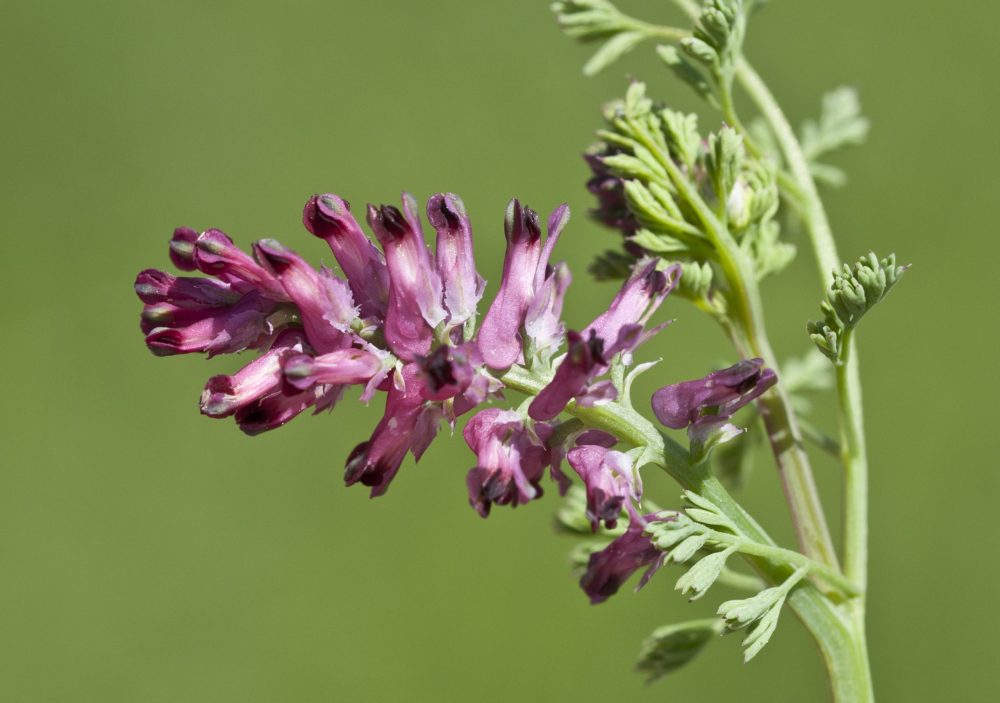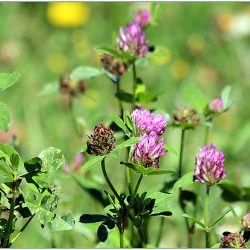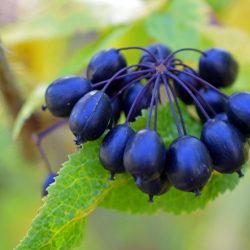The belief of the Ancients was based on the idea of a plant that was not born from a seed. A plant with ashen leaves, a flavour reminiscent of soot and the smell of smoke, with a vaporous, evanescent appearance that evokes a blurred silhouette just like smoke rising from the bowels of the Earth… This explains why, around the 12th century, this plant was referred to in medieval Latin as fumus terrae, which later gave rise to today’s “fumitory”.
What is fumitory?
Fumitory originally belonged to the Fumariaceae family. However, according to the 2009 APG III phylogenetic classification, this family has been merged with the Papaveraceae. This plant is a dicotyledonous plant in the order Ranunculales.
Among the Papaveraceae are such notable genera as Papaver (Papaver somniferum, the opium poppy, source of opiate drugs), Chelidonium (Chelidonum majus, the chelidonia, used externally against warts and internally as a cholagogue) and Eschscholtzia (Eschscholtzia californica, the California poppy, used as a hypnotic and sedative).
Fumitory is a perennial herbaceous plant. It has slender, angular stems and grows to around 30 cm in height. Its alternate, petiolate leaves are pinnate, reminiscent of a hen’s foot, and grey-green in colour.
Fumitory’s tubular flowers, which are white tinged with pinkish to purple, are numerous and arranged in terminal clusters. The calyx is bisephalous and petaloid, while the corolla has four petals, one of which is spur-shaped at the top.
Fumitory flowers from May to October. Its reproductive system comprises six hypogynous stamens and a gynoecium with a free, unilocular ovary. The fruit is a globose achene, 2 mm in diameter, hairless and green, containing a single beige seed.
Fumitory grows in plains up to 1700 m altitude. It adapts to all types of soil, including the poorest and most unusual, such as ruins and vineyards. It is frequently found in temperate zones of the northern hemisphere, particularly in Europe and Asia.
A little history
Fumitory has been known since Greco-Roman times for its tonic and purifying properties. Galen, a great name of that era, recommended it for treating obstructions of the liver and hepatic disorders.
During the Middle Ages, fumitory was rarely mentioned and was mainly used by Arab physicians such as Serapion, Avicenna and Mésué. They praised its many virtues, which were effective for the liver, gallbladder and blood. It was reputed to cure eye diseases and, when applied externally, to treat scabs and warts. It was even used to make a “beauty water” for a radiant complexion.
During the Renaissance, Matthiole, influenced by Mésué, described fumitory as a mild purgative. He emphasised its role in strengthening the viscera, unclogging the liver and its depurative action on the blood, beneficial against certain skin diseases.
In the 17th century, doctors such as Johann Schroder and Lazare Rivière confirmed its action on the spleen, liver and gall bladder, while highlighting its importance as a blood depurative. Its name, fumitory, derives from the Latin “fumus terrae”, referring to its greyish, smoke-like leaves. Its pungent juice makes the eyes water, hence its various names, such as gelatin foot or jaundice herb.
Olivier de Serres, a French agronomist in the early 17th century, already recognised its virtues for cleansing the humours and treating gravel (kidney or gallstones). In ancient times, Galen recommended it for liver problems, and Dioscorides, a disciple of Hippocrates, prescribed it to stimulate urinary secretion. In the nineteenth century, one doctor attributed benefits to it against arteriosclerosis,hypercholesterolaemia, blood thinning and various skin problems. In the past, it was also used as a floral water for local applications.
What are the main pharmacological properties of the aerial flowering parts of Fumitory?
The aerial flowering parts of Fumitory have interesting pharmacological properties that have attracted the interest of researchers. Fumitory, like artichoke, rosemary and boldo, is on list A of traditional medicinal plants. The flowering tops, harvested in June, are used in the Pharmacopoeia. Rich in isoquinoline alkaloids such as protopine, fumaricin, fumarofine, sinactine and cryptopine, these compounds regulate the secretion of bile, reducing or increasing its flow as required. They also have a cholagogue effect.
Fumitory also contains tannins, flavonic heterosides such as rutin, and minerals such as potassium, which promotes diuresis and contributes to the plant’s depurative action. Malic, fumaric and citric acids have also been identified. All these compounds act in synergy, giving fumitory its properties as a depurative, diuretic and bile flow regulating plant.
Digestive properties
Amphocholeretic activity
Fumitory, known for its cholagogue properties, plays a key role in regulating bile flow. Protopine, a major alkaloid in this plant, stimulates bile secretion and reduces pathological hypersecretion.
An in vivo clinical study compared the effect of fumitory with a placebo in people with no hepatobiliary disease. This research demonstrated its amphocholeretic action. Depending on the initial rate of choleresis, fumitory increases choleresis by 37% if the flow rate is low, and reduces it by 63% if the flow rate is high. For a medium flow rate, the variations are minimal and not significant. Several other studies have confirmed this unique feature, highlighting the amphocholeretic activity of fumitory.
As an amphocholeretic, fumitory adjusts bile production. It stimulates this secretion by the liver cells or reduces production if necessary. It thus supports the well-being of the liver, which is particularly useful after dietary abuse (processed foods, alcohol, fatty foods).
Action on hepatobiliary disorders
Dermatological properties
Beneficial in dermatology thanks to the fumaric acid it contains, fumitory is traditionally used in many countries to treat skin disorders (dermatitis, particularly atopic dermatitis, eczema, psoriasis, etc.). The action of fumaric acid has been confirmed in several randomised, controlled studies on patients and in an in vitro study on human blood mononuclear cells isolated from psoriasis patients.
Fumitory, with its antihistaminic properties due mainly to protopine, is also notable for its anti-infectious properties. Its antistaphylococcal bactericidal properties come from certain isoquinoline alkaloids such as allocryptopine, sanguinarine and berberine. This depurative medicinal plant is effective in combating skin diseases such as atopic skin, eczema, dermatitis, psoriasis and darting.
Fumitory helps to reduce skin itching thanks to its antihistaminic effects. Used externally, it is effective against eczema and psoriasis, targeting their inflammatory component.
A study on patients with eczema of the hands demonstrated the efficacy of a cream containing 4% Fumitory extract compared with a placebo. Applied twice a day for four weeks, this cream revealed fumaric acid as an active anti-eczematous and anti-psoriatic agent, offering immunomodulatory and T-cell inhibitory action.
Fumaric acid esters have also proved effective on children suffering from intractable psoriasis. Fumitory can reduce acne vulgaris in adolescents, linked to a diet rich in lipids and proteins. As a complete depurative, it encourages the elimination of toxins via the bile and kidney ducts. Fumitory extracts, combined with plants such as wild pansy or burdock, help to revive a blotchy complexion.
Other properties
Fumitory has a sedative effect via protopine, which increases the binding of GABA to central receptors on the brain’s synaptic membranes, as well as a serotonergic effect.
As an acetylcholinesterase inhibitor, in association with certain isoquinoline alkaloids in the plant(fumarine and fumarostrejdine), fumitory has potentially useful properties in Alzheimer’s disease. Fumitory contains several active compounds that could potentially be beneficial in the context of Alzheimer’s disease.
Work in 2019 studied the effect of aqueous and methanolic extracts of F. officinalis on blood glucose levels in normoglycaemic and alloxan-induced diabetic subjects. A significant hypoglycaemic effect was observed at all doses, as well as an improvement in liver and kidney function tests in diabetic subjects, and a reduction in glomerular cell damage, interstitial inflammation, tubular cell necrosis and thrombosis phenomena in the kidneys. This study concludes that fumitory may have anti-diabetic potential, probably due to its antioxidant and alpha-amylase inhibitory activities.
Are there any precautions to be taken when using Fumitory?
Before using Fumitory, it is crucial to be aware of its precautions for use to avoid any undesirable side effects.
Contraindications:
- Inappropriate in cases of obstruction of the bile du cts, stones, or biliary or hepatic diseases.
- The EMA advises against its use in pregnant or breast-feeding women due to the alkaloids it contains.
- Not recommended in cases of hypersensitivity to the active substances.
Precautions for use:
- To be used under medical supervision in cases of severe hepatic insufficiency or stones that may obstruct the bile ducts.
- For adults only.
- Prolonged use may be dangerous due to accumulation of alkaloids.
Drug interactions:
- Possible interactions with certain chemotherapy drugs due to its activity on CYPs.
- Avoid in patients taking cyclosporine.
- Probable inhibition of CYP3A4 by berberine.
Side effects:
- Stomach pain and diarrhoea have been observed in cases of overdose or prolonged use.
- Possible hypersensitivity to one of the components.
Specific drug interactions:
- Decreased absorption of certain other drugs when taken simultaneously with gastrointestinal topicals, antacids or adsorbents.
- Interaction with Colestipol and chelating resins, which may reduce the intestinal absorption of other drugs.
- Association with laxatives (macrogol type), which may reduce the effectiveness of the drug administered with the laxative.
How should Fumitory be taken and at what dosage?
To enjoy the benefits of Fumitory, it’s important to know how to take it and at what dosage. Fumitory, which is recommended by the health authorities, has an average daily dose of 6 g, with various methods of use:
- Standardised fluid extract of fresh plant: 5 to 10 ml per day in water
- Infusion: 2 or 3 g of aerial parts in a cup of boiling water, left to infuse for 10 minutes. Consume half an hour before meals for a ten-day depurative cure. It acts on digestive functions, the liver and gall bladder. Useful against nausea in pregnant women and hepatobiliary migraines.
- Nebulisate: 300 mg, 3 times a day, for a maximum of ten days a month.
- Syrup: 10 g fumitory fluid extract, 50 g gentian syrup, 150 g sarsaparilla syrup. Take 1 to 4 tablespoons a day for a depurative effect and to combat arteriosclerosis.
- Mother tincture: 30 drops, 3 times a day; 100 g of plant per 200 ml of 80° or 90° alcohol.
- Powder: 2 g with a glass of water, three times a day before meals.
- Dry extract: 400 mg with a glass of water, 3 times a day before meals.
As a mild diaphoretic, fumitory helps to reduce fever.
- External use: decoction and compresses, 3 times a day, to treat shingles and other skin conditions such as eczema.
- External infusion: 60 g in ½ litre of milk, boil for 5 minutes, then infuse for 10 minutes.
Although its effectiveness is recognised, fumitory acts slowly on skin problems. It is therefore advisable to use internal and external treatments simultaneously. Fumitory infusion applied topically relieves conjunctivitis.
Fumitory as a magistral preparation of standardised extracts in liquid form (EPS)
Fumitory is also available as a magistral preparation of standardised extracts in liquid form (EPS). In this section, we will explore this form of Fumitory and the advantages it offers over other forms of the plant.
Combination with turmeric and gentian
Fumitory can be combined with turmeric and gentian for digestive problems.
Turmeric, with its volatile compounds such as germacrone, has anti-inflammatory and analgesic effects, effective for both acute and chronic inflammation. These properties are particularly valued in rheumatology, to treat conditions such as arthritis and osteoarthritis. Turmeric acts by reducing the secretion of prostaglandins and inhibiting key compounds such as trypsin and hyaluronidase, thereby reducing joint inflammation.
In terms of liver protection, the curcumin in turmeric activates the liver’s antioxidant enzyme systems, playing a major role in the event of liver damage. In gastrointestinal terms, turmeric stimulates the secretion of gastrin, inhibiting the formation of ulcers and the proliferation of Helicobacter pylori. It also has a choleretic and cholagogue action, aiding digestion and preventing the formation of gallstones.
Gentian root is renowned for its beneficial effects on the digestive system, liver and blood circulation. It stimulates salivary and gastric secretions thanks to its bitter substances, improving digestion and postprandial haemodynamics. Gentian also speeds up gastric evacuation and acts as an anti-gastralgic. It also stimulates the production of digestive enzymes under the influence of the vagus nerve, making it easier to digest food and absorb nutrients.
Combination with lemon balm
Fumitory can be combined with lemon balm to treat gastralgia caused by bile reflux, nausea and intestinal spasms.
Total extract of lemon balm, used in addition to the usual treatments, has been shown to be effective in reducing abdominal pain and bloating in people suffering from irritable bowel syndrome.
A study carried out in 2013-2014 on 100 secondary school girls found that lemon balm significantly reduced the symptoms of premenstrual syndrome. In addition, a double-blind clinical trial in 2017 showed that taking lemon balm reduced dysmenorrhoea, thanks to its antispasmodic activity.
In terms of gastrointestinal protection, lemon balm protects against ulcers by increasing the secretion of mucins and prostaglandins E2, while reducing the release of leukotrienes.
Its lipid-lowering action has been identified as effective in reducing total cholesterol and serum lipid levels, reducing lipid peroxidation and increasing hepatic glutathione levels. It also influences weight gain, body fat and lipid metabolism.
On the antimicrobial and antiparasitic front, lemon balm is active in vitro against various bacteria, yeasts, fungi and parasites, including Herpes simplex, particularly type 2.
Lemon balm’s antioxidant activity, due to the presence of rosmarinic acid and flavonoids, has been demonstrated in vitro. This property offers protection against oxidative stress, as observed on human vascular endothelial cells. Regular consumption of lemon balm infusion also reduces markers of oxidative stress and stimulates antioxidant defences, particularly in hospital staff exposed to radiation.
Association with artichoke
Fumitory can be combined with artichoke for post-cholecystectomy digestive disorders.
Artichoke, rich in flavonoids (luteolin flavonol), has important hepatobiliary properties. It acts as a cholagogue, amphocholeretic (regulating choleresis), cholecystokinetic and anticholestatic. This increase in the secretion and elimination of bile acids makes artichokes effective against dyspepsia and irritable bowel syndrome.
A clinical trial in 2003 demonstrated the significant efficacy of aqueous artichoke leaf extract in treating functional dyspepsia. As an antioxidant, the ethanolic extract of artichoke shows powerful antioxidant activity, in particular by increasing glutathione peroxidase. The extracts inhibit the production of reactive forms of oxygen in cells, protecting against oxidative stress induced by inflammatory mediators and oxidised LDL cholesterol.
As a hepatoprotector, artichoke promotes liver regeneration by inhibiting intracellular protein kinases, limiting nitrosation and inducing apoptosis. At intestinal level, the insulin in artichokes has a bifidogenic effect, stimulating the bifidobacteria that are beneficial to intestinal health and the immune system. It also modifies the composition of the intestinal microbiota.
In terms of lipid-lowering, artichoke inhibits hepatic cholesterol synthesis and reduces the concentration and oxidation of LDL cholesterol, which is useful in cases of hyperlipoproteinaemia. In terms of metabolic properties, artichoke has a mild to moderate inhibitory effect on the key enzymes involved in metabolic syndrome and is also a hypo-uricaemic, inhibiting xanthine oxidase.
Association with burdock and wild pansy
Fumitory can be combined with burdock and wild pansy to treat dermatitis and eczema.
Medical literature and clinical trials
- Reynier, M., Lagrange, E., & Godard, F. (1977). Action of Fumitory nebulisate on smooth muscles
- A. A. Izzo, G. di Carlo, D. Biscardi, R. de Fusco, N. Mascolo, F. Borrelli, F. Capasso, M. P. Fasulo, G. Autore. Biological screening of Italian medicinal plants for antibacterial activity. Phytotherapy Research, Volume 9, Issue 4, pages 281-286, June 1995
- Chlebek J, Novák Z, Kassemová D, Šafratová M, Kostelník J, Malý L, Ločárek M, Opletal L, Hošt’álková A, Hrabinová M, Kuneš J, Novotná P, Urbanová M, Nováková L, Macáková K, Hulcová D, Solich P, Pérez Martín C, Jun D, Cahlíková L. Isoquinoline Alkaloids from Fumaria officinalis L. and Their Biological Activities Related to Alzheimer’s Disease. Chem Biodivers. 2016
- Vrancheva RZ, Ivanov IG, Aneva IY, Dincheva IN, Badjakov IK, Pavlov AI. Alkaloid profiles and acetylcholinesterase inhibitory activities of Fumaria species from Bulgaria. Z Naturforsch C. 2016
- Orhana I, Ozçelik B, Karaoğlu T, Sener B. Antiviral and antimicrobial profiles of selected isoquinoline alkaloids from Fumaria and Corydalis species. Z Naturforsch C. 2007
- Sladden M.J. et al, Fumaric acid esters for severe psoriasis: the Leicestershire experience, Br J Dermatol, 2006
- Ustunes L. et al, In vitro study of the anticholinergic and antihistaminic activities, J Nat Prod, 1988
- Roux M., Le nébulisât de fumeterre dans la régulation des troubles intestinaux chroniques d’origine biliaire, Gazette Médicale de France, 1977
- Casili G., Cordaro M., Impellizzeri D. et al, Dimethyl Fumarate Reduces Inflammatory Responses in Experimental Colitis, J Crohns Colitis, 2015
- Fatima S. et al, Antioxidant and alpha amylase inhibitory activities of Fumaria officinalis and its antidiabetic potential against alloxan induced diabetes, Cell Mol Biol, 2019







